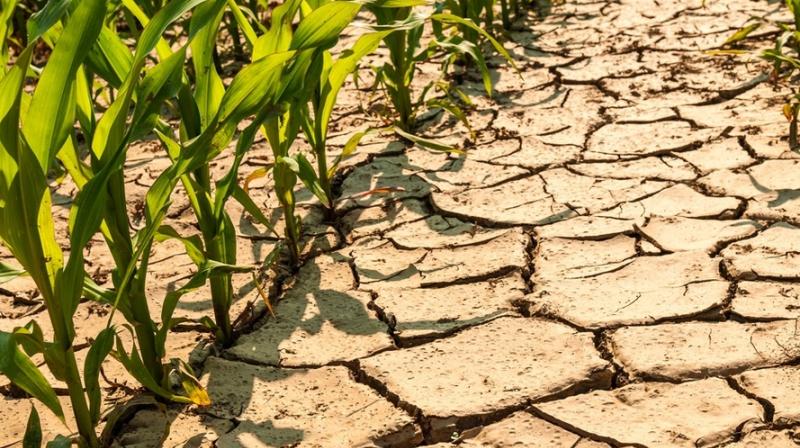J&K Records Lowest Rainfall in 50 Years: Water Scarcity Threatens Agriculture, Hydropower, and Daily Life
By: Javid Amin
Srinagar 11 Jan: Jammu and Kashmir, renowned for its natural beauty and pristine water bodies, is now grappling with an alarming environmental crisis: its driest year in five decades. With rainfall levels dropping to just 870.9 mm—a staggering 29% deficit compared to the normal annual average of 1232.3 mm—the region faces cascading impacts on agriculture, hydropower, and daily life. This marks the fifth consecutive year of below-normal precipitation, heightening concerns about water scarcity and the region’s future sustainability.
The Decline of Rainfall: A Five-Year Snapshot
Over the past five years, Jammu and Kashmir has seen a concerning pattern of declining rainfall. Here’s a breakdown of the deficit year by year:
- 2020: 982.2 mm (20% below normal)
- 2021: 892.5 mm (28% below normal)
- 2022: 1040.4 mm (16% below normal)
- 2023: 1146.6 mm (7% below normal)
- 2024: 870.9 mm (29% below normal)
The 2024 rainfall figures approach the record low of 802.5 mm, set in 1974, placing the region at a tipping point where immediate action is essential.
Impact on Agriculture: The Lifeblood of J&K
Agriculture forms the backbone of Jammu and Kashmir’s economy, with paddy cultivation as a cornerstone activity. However, the water scarcity caused by consecutive years of low rainfall is reshaping the region’s agricultural landscape:
- Lower Crop Yields:
The delayed and insufficient monsoons have directly impacted the sowing and growth cycles of crops. Farmers report reduced yields, particularly in water-intensive crops like rice, vegetables, and maize. - Groundwater Stress:
To compensate for dwindling rainfall, farmers have increasingly relied on groundwater for irrigation. However, over-extraction has led to declining groundwater levels, creating a vicious cycle of resource depletion. - Economic Fallout:
With reduced agricultural output, local markets have seen a rise in food prices. Small and marginal farmers, who form a majority in the region, are bearing the brunt, facing financial instability and, in some cases, migration. - Food Security Threats:
Lower productivity has raised concerns about food security in the region, with potential ripple effects on adjoining states dependent on J&K’s agricultural exports.
Hydropower: A Sector Under Stress
Jammu and Kashmir’s rivers—Jhelum, Chenab, and Ravi—are lifelines for the region’s hydropower sector, which supplies electricity locally and to northern states. However, the declining water flow poses significant challenges:
- Reduced Generation Capacity:
Lower river water levels have hampered the operational efficiency of major hydropower plants, affecting energy output and revenue generation. - Energy Shortages:
Both urban hubs like Srinagar and rural areas are reporting periodic power shortages, highlighting the hydropower sector’s dependency on stable water resources. - Revenue Declines:
With reduced energy exports, J&K’s economy faces significant financial losses, further stressing state budgets.
Daily Life: Disruptions for Residents
The prolonged dry spells have trickled down to affect the daily lives of millions across J&K:
- Water Supply Challenges:
Households, particularly in urban centers like Srinagar and remote villages, are experiencing water shortages. Dependence on tanker services has surged, adding financial and logistical burdens. - Sanitation Issues:
Reduced water availability has impacted sanitation and hygiene, exacerbating health risks in densely populated areas. - Livelihood Losses:
Tourism, a major livelihood source, is also indirectly affected as dry landscapes diminish the region’s scenic charm.
Expert Insights: The Growing Climate Crisis
Independent weather forecaster Faizan Arif attributes the persistent dry spells to changing climate patterns, emphasizing the need for robust water management systems. He warns that the dwindling precipitation levels could become the norm unless sustainable practices are implemented promptly.
The Way Forward: Sustainable Solutions for J&K
The rainfall crisis in Jammu and Kashmir is a wake-up call for policymakers, environmentalists, and residents. A multi-pronged approach is needed to combat water scarcity and its far-reaching impacts:
- Water Management Strategies:
- Invest in rainwater harvesting systems to capture and store seasonal rains.
- Develop efficient irrigation techniques, such as drip and sprinkler systems, to reduce water wastage.
- Policy Interventions:
- Strengthen policies that regulate groundwater extraction.
- Encourage afforestation and catchment area restoration to enhance natural water retention.
- Public Awareness Campaigns:
Educate communities about water conservation through local campaigns and workshops. - Hydropower Optimization:
Implement advanced technologies to optimize hydropower generation during periods of low water availability. - Agricultural Adaptation:
Promote the cultivation of drought-resistant crops and provide subsidies for adopting sustainable farming techniques.
Bottom-Line
The record-low rainfall in Jammu and Kashmir serves as a stark reminder of the region’s vulnerability to climate change. Addressing water scarcity isn’t just an environmental issue—it’s a matter of survival for the region’s people, economy, and ecosystems.


